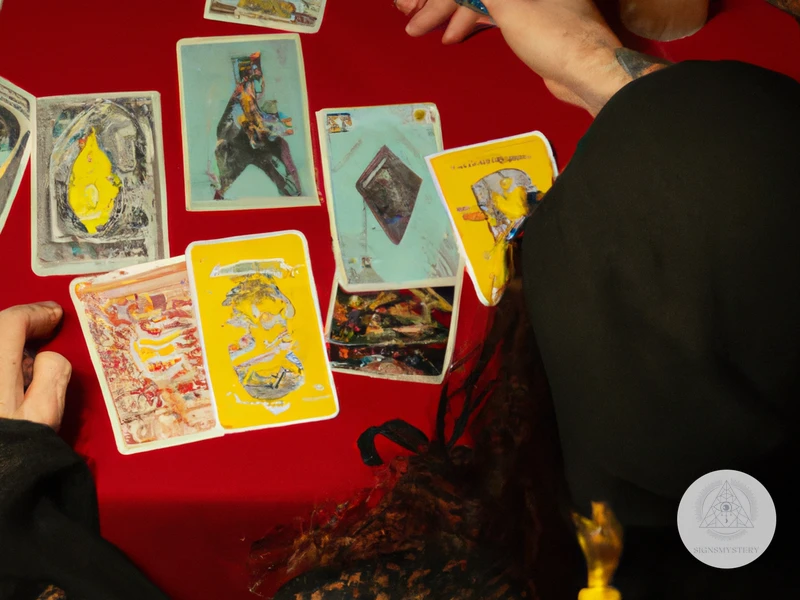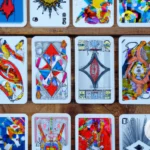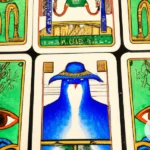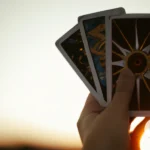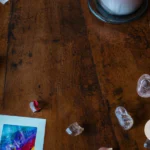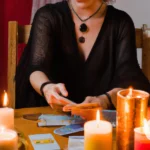Tarot cards have been used for centuries as a tool of divination, providing insights and guidance into the past, present, and future. However, it was not until the 19th century that tarot cards became widely popular for fortune-telling. During this time, the rise of spiritualism and occultism created a renewed interest in mysticism and the supernatural. Notable tarot readers emerged, utilizing various tarot spreads and interpretations to analyze the meaning of each card. In this article, we will delve into the origins of tarot cards, their popularity in the 19th century, and the practice of reading tarot cards for fortune-telling.
The Origins of Tarot Cards
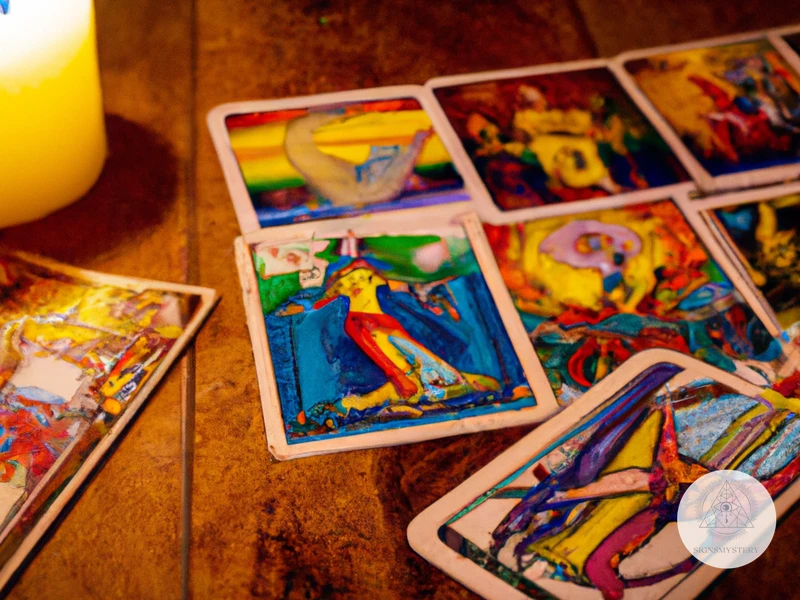
The origins of tarot cards are shrouded in mystery, with historians and scholars offering differing perspectives on their origins. One common belief is that tarot cards originated in medieval Italy as a game played by the nobility. While the game of tarot was popular, it wasn’t until the 18th century that the cards began to be used for divination purposes. The late 18th and early 19th centuries saw a boom in interest in the occult, and tarot cards were seen as an important tool for divination. Many modern tarot decks draw on the iconography and symbolism of traditional tarot cards, with images of the Fool, the Magician, and the High Priestess being common motifs. Tarot spreads, or the way cards are laid out during a reading, have also evolved over time, with some popular spreads tracing their origins back to the 19th century.
The First Tarot Cards
The first tarot cards emerged in Italy in the early 15th century and were used primarily for playing games, rather than divination. In fact, it wasn’t until the 18th century that tarot cards began to be used for fortune-telling. The original tarot decks were hand-painted, with the earliest surviving examples being the Visconti-Sforza deck, which dates back to the mid-15th century.
These early tarot cards were similar in many ways to standard playing cards, with four suits – swords, cups, coins, and batons – each containing ten pip cards and four court cards. However, in addition to these cards, the tarot deck contained an extra 22 cards, known as the Major Arcana. These cards featured powerful images such as The Fool, The Magician, and The Hierophant.
The origins of these 22 cards are somewhat mysterious, but it is believed that they were added to the deck in the early 15th century, and that they may have been inspired by medieval allegorical works or by the powerful imagery of the Italian Renaissance. Regardless of their origins, these cards would ultimately prove to be the most significant part of the tarot deck, and would come to be associated with mysticism and divination.
It is interesting to note that the earliest tarot cards did not feature the now-iconic imagery that is commonly associated with tarot, such as the waif-like figure of The Fool or the enigmatic High Priestess. Instead, the cards were decorated with simple, straightforward images that depicted scenes from everyday life.
Despite their humble origins, tarot cards would eventually become powerful tools for divination and self-discovery. But before they could fulfill this role, they would need to undergo many changes and adaptations over the centuries, which would help to increase their popularity and cement their place in modern culture.
The Use of Tarot Cards in Divination
The use of Tarot cards in divination originated in the late 18th century when French and English occultists began incorporating them into their practices. Divination, broadly defined, is the practice of seeking insight or knowledge through supernatural or magical means. Tarot cards were initially used as playing cards, and it wasn’t until the practice of divination arose that they took on their current role as fortune-telling tools.
Divination with Tarot cards typically involves a reader laying out a spread, which is a predetermined arrangement of cards. Each position in the spread has a specific meaning, and the cards that are drawn for each position are said to provide insight into various aspects of the querent’s life, including their past, present, and future.
Tarot card readings are believed to offer access to higher knowledge and hidden truths, allowing the querent to gain insight into their life path and make more informed decisions. Some people find tarot readings to be a source of guidance and inspiration, while others use them simply as a form of entertainment.
It’s important to note that Tarot cards are not considered to be a form of divination by all practitioners. In fact, some people believe that the cards are simply a tool for accessing the reader’s own intuition or subconscious mind, rather than a means of communicating with supernatural forces.
Despite this controversy, the use of Tarot cards in divination remains a popular practice to this day. Whether you see them as a form of magic or simply a tool for self-reflection, there’s no denying that Tarot cards have a rich history and an enduring appeal.
The Popularity of Tarot Cards in the 19th Century
During the 19th century, tarot cards grew in popularity as a tool for divination and fortune-telling. This was due in part to the rise of spiritualism and occultism, which gained traction during this time period. Notable tarot readers included French occultist Jean-Baptiste Alliette, who wrote under the pseudonym Etteilla, and English mystic Arthur Edward Waite, who published the popular Rider-Waite tarot deck, still widely used today. The appeal of tarot readings during the 19th century can be attributed to a desire for information about the future, as well as the entertainment value of the practice. Additionally, many individuals turned to tarot cards for self-exploration and spiritual growth. The practice of reading tarot cards for fortune-telling often involved interpreting the meanings of the cards in combination with other divination tools, such as astrology or numerology.
The Rise of Spiritualism and Occultism
The 19th century saw a significant rise in spiritualism and occultism, which contributed greatly to the popularity of tarot cards as a tool for fortune-telling. Spiritualism was a movement that emerged in the United States in the mid-19th century, which held that the spirits of the dead could communicate with the living. This belief quickly spread throughout Europe and became a popular pastime for the middle and upper classes. Spiritualists often used mediums to communicate with the dead, and some mediums claimed to have the ability to predict the future.
Occultism, on the other hand, was a broader movement that encompassed a wide variety of esoteric practices, including astrology, alchemy, and ritual magic. Many occultists believed in the existence of hidden truths and secret knowledge that could be accessed through mystical or supernatural means. Tarot cards were seen as a tool for unlocking these hidden truths and were often used in conjunction with other occult practices.
The rise of spiritualism and occultism created a fertile ground for the popularity of tarot cards, which were seen as a way to access hidden information and gain insights into the future. Tarot readings were often conducted in the parlors of wealthy individuals, and many famous writers and artists of the time were known to dabble in tarot card reading.
The popularity of tarot cards in the 19th century was closely linked to the rise of spiritualism and occultism. These movements created a fascination with hidden knowledge and the supernatural, which tarot cards were seen as being able to access. As a result, tarot cards became a staple tool for fortune-tellers and a popular pastime for people of all classes.
Notable 19th Century Tarot Readers
Among the most outstanding 19th century tarot readers was the French tarot master Jean-Baptiste Alliette, who is also known as Etteilla. He was one of the most influential tarot readers in the 18th and 19th centuries and has been credited with the creation of the modern tarot deck. His deck featured illustrated pips for the minor arcana rather than the traditional suit symbols, and his interpretations of the cards were based on divinatory meanings.
Another notable figure of this era was Marie Anne Lenormand, a renowned French fortune-teller who used her own deck of 36 cards with images of objects such as keys, anchors, and flowers instead of traditional tarot cards. She was known for her ability to read people’s fortunes with remarkable accuracy, and her clients included the likes of Robespierre, Napoleon, and Josephine de Beauharnais.
In Italy, Carlo delle Nocche was a renowned tarot reader, and his book “Il Libro di Thot” (The Book of Thoth) was considered one of the most important works on tarot interpretation. He emphasized the importance of the Fool card in readings and believed that tarot could be used as a tool for spiritual growth.
Pamela Colman Smith was an American artist who illustrated and designed the Rider-Waite-Smith tarot deck with Arthur Edward Waite. The deck, which has become one of the most popular and well-known tarot decks in the world, features illustrations with rich symbolism and imagery.
These 19th century tarot readers have left a lasting impact on the world of tarot and fortune-telling. Their contributions not only helped shape the art of tarot reading but also sparked interest and curiosity in the general public. Today, their legacies continue to inspire and influence tarot readers and enthusiasts around the world.
The Practice of Reading Tarot Cards for Fortune-Telling
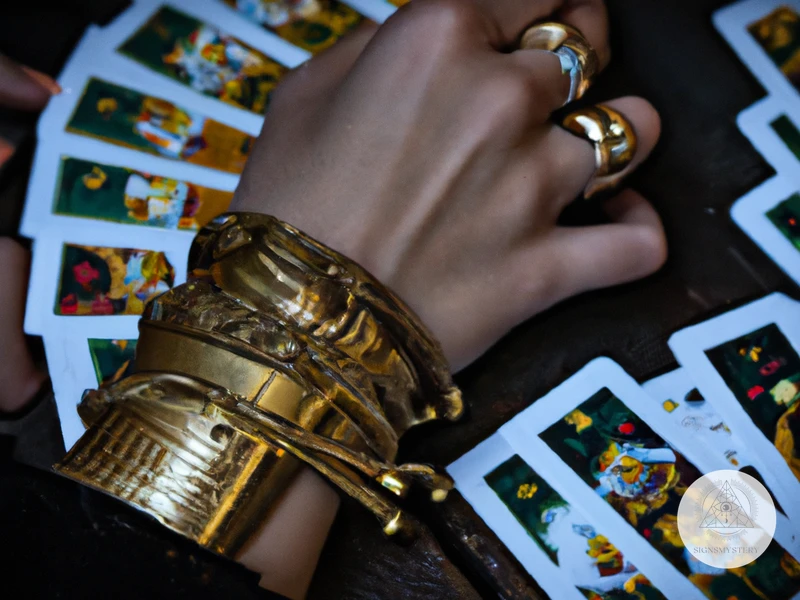
A tarot reading for fortune-telling involves the shuffling of tarot cards and the selection of a specific spread. The role of the reader is to interpret the cards, taking into account their meanings as well as their positioning in the spread. Common tarot card spreads include the Celtic Cross and the Three-Card Spread, each of which has a unique significance. The interpretation of tarot card meanings requires a deep understanding of the symbolism and archetypes represented within the deck. Tarot cards can also be used in combination with other divination tools, such as astrology or numerology, to create a more comprehensive reading. For those interested in the history of tarot, a study of the origins of tarot cards and the evolution of their popularity can provide valuable insight into the practice of reading tarot cards for fortune-telling.
The Role of the Reader
In the practice of fortune-telling with tarot cards, the reader plays a crucial role. They are responsible for interpreting the cards and conveying their meanings to the querent, the person seeking the reading.
The reader is often seen as a mediator between the querent and the divine or spiritual realm. They use their knowledge of the symbolism and meanings of the cards, as well as their intuition and psychic abilities, to provide guidance and insight.
There are different approaches to reading tarot cards, and the role of the reader can vary depending on the tradition or school of thought. However, some common aspects of the reader’s role include:
| Aspect of the Reader’s Role | Description |
|---|---|
| Preparing the Space | Before the reading, the reader may cleanse and consecrate the space and the deck of cards, to create a sacred or protected space for the session. |
| Connecting with the Querent | The reader may engage in small talk or establish a rapport with the querent, to create a comfortable and trusting atmosphere, and to understand the querent’s needs and intentions for the reading. |
| Shuffling and Choosing the Cards | The reader may ask the querent to shuffle the deck while focusing on their question or issue, or they may shuffle the cards themselves. The reader may then cut the deck or choose the cards using a specific method or spread. |
| Interpreting the Cards | The reader uses their knowledge of the cards’ meanings, as well as their own intuition and psychic impressions, to provide insights and guidance related to the querent’s question or issue. The reader may also encourage the querent to reflect on their own interpretation of the cards, and to ask clarifying questions. |
| Concluding the Reading | The reader may offer closing remarks or affirmations, and may suggest follow-up actions or resources for the querent. The reader may also encourage the querent to trust their own intuition and continue the self-exploration or spiritual journey that the reading may have initiated. |
The role of the reader in tarot card fortune-telling involves sensitivity, insight, and empathy towards the querent, as well as knowledge and respect for the symbolism and structure of the cards. The reader serves as both a guide and a messenger, helping the querent to connect with their inner wisdom and the hidden truths of the universe.
To deepen your understanding of tarot card symbolism and meanings, see our detailed study on Tarot Icons and Symbolism. Or, if you’re interested in the historical development of tarot card spreads, check out our article on the History of Tarot Spreads.
The Significance of Tarot Card Spreads
Tarot card spreads are an essential part of the tarot reading process. The way tarot cards are arranged during the reading is just as crucial as the cards themselves. Every spread has its unique name, structure, and significance. Different spreads are used for different types of readings, from love and relationships to career and finances.
One of the most popular tarot spreads is the Celtic Cross spread. It consists of ten cards and provides deep insight into the querent’s current situation and future possibilities. Each card in this spread represents a specific aspect of the querent’s life, such as their personality, challenges, hopes and fears, and potential outcomes.
Another widely used spread is the three-card spread, known as Past-Present-Future. As the name suggests, it provides information about the querent’s past, present, and future. It’s a simple yet powerful spread, allowing the reader to reveal the root cause of the querent’s current situation and offer guidance towards a positive outcome.
The significance of tarot card spreads lies in their ability to tell a story. The cards are not randomly placed; instead, they are arranged in a specific order that creates a narrative. Each card’s meaning is influenced by its position in the spread and the cards around it. The reader must interpret the cards in the context of the spread to provide an accurate reading.
The significance of tarot card spreads also lies in their versatility. Readers can create their spread or modify existing ones to suit the querent’s needs. Some spreads are designed for specific questions or issues, such as the relationship spread, which is used to explore romantic relationships. Others are more general and can be used for any type of reading.
Tarot card spreads are a crucial aspect of tarot reading. They provide structure, context, and meaning to the cards, allowing the reader to offer accurate and insightful guidance. The significance of tarot card spreads lies in their ability to tell a story and their versatility. By understanding the different types of spreads and their significance, readers can offer a more personalized and meaningful tarot reading experience.
The Interpretation of Tarot Card Meanings
Interpreting tarot card meanings is a crucial aspect of tarot card reading. Each card has its own set of meanings, and understanding them is essential for gaining insight into the querent’s situation. Below are some tips for interpreting tarot card meanings:
| Card Position | Card Meaning |
|---|---|
| Upright Position | When the card is upright, it generally represents positive aspects of the querent’s life or situation. |
| Reversed Position | When the card is reversed, it usually indicates blockages or negative aspects. |
| Suit Meanings | The suit of the card can also provide additional information about its meaning. For example, the cups represent emotions, while the pentacles represent material abundance. |
| Numerology | The number on the card can also impact its meaning. For instance, the number one can indicate new beginnings, while the number ten represents completion. |
| Visual Cues | Visual cues on the card can offer up meaning as well. For example, a card with a person blindfolded may indicate a need to look inward for answers. |
| Context | The context in which the card appears can also impact itsSubscribe to Our NewsletterSign up to receive the latest news and updates. |
Interpreting tarot card meanings takes time, practice, and an understanding of symbolism and numerology. A skilled tarot card reader can bring their understanding of these elements together to provide a clear and insightful interpretation for the querent.
The Use of Tarot Cards in Combination with Other Divination Tools
While tarot cards can be used on their own for divination, they were often combined with other divination tools to enhance their predictive power and gain deeper insights. Some popular divination tools that were often used in combination with tarot cards in the 19th century included:
- Crystals: Crystals were believed to have powerful energy that could be harnessed for divination purposes. In combination with tarot cards, crystals were often used to focus the reader’s energy and enhance the accuracy of the reading.
- Palmistry: Palmistry, or the study of the lines on a person’s hands, was another popular form of divination in the 19th century. Tarot cards were often used in combination with palmistry to provide a more comprehensive reading of the individual’s past, present, and future.
- Astrology: Astrology, the study of the position and movements of celestial bodies, was also commonly used in combination with tarot cards. The reader would use the individual’s astrological chart to gain deeper insights into their personality, life path, and future.
- Runes: Runes are ancient symbols that were used in divination by the Norse people. In combination with tarot cards, runes were often used to provide additional clarity and insight into the individual’s question or situation.
By combining tarot cards with other divination tools, readers could provide more detailed and accurate readings for their clients. This practice continues to this day, with many modern readers incorporating a variety of divination tools into their tarot card readings.
The Appeal of Tarot Cards in 19th Century Fortune-Telling
The appeal of tarot cards in 19th century fortune-telling can be attributed to several factors. Firstly, there was a desire for information about the future, especially during uncertain times such as wars and economic instability. Tarot card readings offered a sense of control and understanding in these unpredictable circumstances. Additionally, tarot cards were used for self-exploration and spiritual growth, providing insights and guidance on personal matters. Secondly, tarot readings provided entertainment value as a form of fun and curiosity. It was a popular pastime for women and men alike, as tarot cards were easily accessible and affordable. Lastly, the symbolism and archetypes depicted in tarot cards resonated with the cultural fascination with the esoteric, mysticism, and the supernatural. Tarot cards were able to captivate people’s imagination, both as a tool for divination and as a form of art.
The Desire for Information about the Future
Throughout human history, there has been a persistent fascination with divination and forecast of the future. The 19th century was no exception, and tarot cards became an incredibly popular tool for those seeking answers about their future. People believed that tarot cards could offer insight into their personal lives, relationships, and even provide guidance on what the future holds.
With tarot cards, individuals could seek clarity on important aspects of their lives, such as career, love, family, and finances. The desire for information about the future was strong because people wanted to have control over their lives and make informed decisions. Tarot cards were seen as a way to gain insight into what was to come, allowing people to navigate their lives with greater confidence.
For many, tarot cards offered a sense of hope and comfort during difficult times. The unknown can be scary, but tarot cards provided a way to gain insight into the future, giving individuals a greater sense of control. This desire for information was not limited to those facing hardship or challenges, but also to those who were curious about what their future holds.
Tarot cards provided a sense of adventure and excitement, as the act of getting a reading was often viewed as a thrilling experience. The idea of uncovering hidden truths and secrets was alluring, and many people couldn’t resist the temptation to see what the cards had in store for them.
The desire for information about the future was a strong motivator for people seeking tarot readings in the 19th century. The ability to gain insight into their lives and make informed decisions was incredibly appealing, and tarot cards provided a sense of hope and comfort during challenging times. The thrill of getting a reading added to the allure of tarot cards, and their popularity only grew throughout the century.
The Use of Tarot Cards for Self-Exploration and Spiritual Growth
The use of tarot cards for self-exploration and spiritual growth gained popularity in the 19th century as individuals sought to delve deeper into their own psyche and spirituality.
Tarot cards were believed to offer a window into the unconscious mind, allowing the reader to access hidden thoughts, emotions and desires. Through the exploration of these concepts, individuals could gain a deeper understanding of themselves and their place in the world.
The symbolism of the tarot cards was also seen as a tool for personal growth and spiritual development. Each card represented a different aspect of the human experience, and their meanings could be interpreted in a myriad of ways.
Individuals could use tarot readings as a way to reflect on their own experiences and gain a better understanding of their own spiritual path. By meditating on the imagery and symbolism present in the cards, they could discover new insights about themselves and their place in the world.
Tarot readings could offer a sense of guidance and clarity, helping individuals to make important decisions and plot their course in life. Many people turned to tarot readings as a way to gain insight into their own journey, and to find meaning and purpose in their lives.
For those seeking spiritual growth, tarot readings were seen as a way to connect with the divine and gain a deeper understanding of the universe. The cards offered a way to examine life’s biggest questions and mysteries, allowing individuals to tap into their own intuition and spiritual insight.
The use of tarot cards for self-exploration and spiritual growth was a key aspect of their popularity in the 19th century. For those seeking deeper insight into themselves and their place in the world, tarot readings offered a means to explore hidden thoughts, emotions, and desires, and to gain a greater sense of clarity and purpose in life.
The Entertainment Value of Tarot Readings
The entertainment value of tarot readings cannot be ignored, especially when looking at their popularity in the 19th century. Tarot readings were not only a tool for divination and self-exploration, but also a form of entertainment for those seeking it. It was not uncommon for tarot readers to perform readings at social gatherings or events, such as parties and fairs.
The Art of Performance
Tarot readings were often performed in a theatrical manner during this time. The reader would dress up in elaborate costumes and use props, such as candles and incense, to enhance the mood and atmosphere. The performance aspect of tarot readings added to their entertainment value and helped to create a sense of mystique and intrigue.
The Power of Suggestion
Part of the entertainment value of tarot readings lies in the power of suggestion. Tarot readers were skilled at creating a sense of mystery and wonder during their readings, often leaving their clients feeling awed and inspired. This was achieved through a combination of performance, language, and symbolism. The reader would use evocative and vague language, leaving room for interpretation and allowing the client to project their own hopes and fears onto the reading.
The Thrill of the Unknown
Another aspect of the entertainment value of tarot readings is the thrill of the unknown. The idea that one’s future is being revealed through the cards can be exciting and captivating. Tarot readings offer a glimpse into the unknown and provide individuals with the possibility of a different and more desirable future.
A Form of Socializing
Finally, tarot readings were a form of entertainment that allowed people to socialize and connect. At social events, tarot readings provided an opportunity for people to come together and bond over a shared experience. It was a chance for individuals to connect with one another on a deeper level and to gain insight into their own lives and the lives of those around them.
The entertainment value of tarot readings was an important aspect of their popularity in the 19th century. The art of performance, the power of suggestion, the thrill of the unknown, and the opportunity for socializing all contributed to their appeal as a form of entertainment. Today, tarot readings continue to be popular, not only for their divinatory and self-exploratory qualities, but also as a form of entertainment and socializing.
Conclusion
In conclusion, the use of Tarot cards for fortune-telling in the 19th century was a significant cultural phenomenon that emerged during a time of great social and spiritual change. The rise of spiritualism and occultism led to a growing interest in Tarot cards, and many notable 19th century Tarot readers emerged, capturing the imaginations of people from all walks of life.
The practice of reading Tarot cards for fortune-telling involved a complex system of interpretation and symbolism, with the role of the reader being critical to the success of the reading. Tarot card spreads were essential in providing a framework for the reading, with each position having a unique significance that contributed to the overall meaning of the reading.
The interpretation of Tarot cards was a nuanced and complex process that required a deep understanding of symbolism, mythology, and spiritual traditions. Many Tarot readers combined the use of Tarot cards with other divination tools to enhance their readings, such as astrology, numerology, and palmistry.
The appeal of Tarot cards in 19th century fortune-telling can be attributed to a variety of factors. People were drawn to Tarot readings to gain insight into their future, to explore their own spiritual growth, and for entertainment purposes.
Overall, Tarot cards played a significant role in 19th century fortune-telling, and their popularity continued to grow as people sought answers to life’s most profound questions. While the practice of Tarot readings has evolved over time, the fascination with these mysterious cards endures to this day.
Frequently Asked Questions
What is the origin of tarot cards?
Tarot cards were first used in Italy during the 15th century for playing games. It wasn’t until later that they were adapted for use in divination and fortune-telling.
What is the difference between a tarot card reading and a psychic reading?
While a psychic reading may involve various tools or methods, tarot cards are typically used specifically in a tarot card reading to interpret the past, present, or future.
Are tarot cards considered to be a form of witchcraft or magic?
While some may believe in the spiritual or mystical qualities of tarot cards, they are not inherently linked to any particular religion, belief system, or form of magic.
Can anyone learn to read tarot cards?
Yes, anyone can learn to read tarot cards with practice and study. There are many resources available online or in-person for beginners.
What is a tarot card spread?
A tarot card spread refers to the specific arrangement or pattern in which the cards are laid out during a reading. This can vary depending on the reader and the focus of the reading.
What is the significance of the major and minor arcana in tarot cards?
The major arcana cards typically represent significant life events or themes, while the minor arcana reflects more everyday situations and influences.
Can tarot cards accurately predict the future?
While tarot cards are often used to gain insight into potential future outcomes, it is important to remember that they should not be relied on as a precise prediction of future events.
Can tarot card readings be done remotely or over the phone?
Yes, tarot card readings can be done both in-person and remotely. Many readers offer virtual readings over the phone or video chat.
What are some common tarot card spreads?
Some common tarot card spreads include the Celtic Cross spread, the Three-Card spread, and the Five-Card spread. Each spread has a different focus and can provide different insights.
Can tarot cards be used for anything other than divination?
While tarot cards are most commonly associated with divination and fortune-telling, some people use them as a tool for self-reflection, meditation, or spiritual development.

